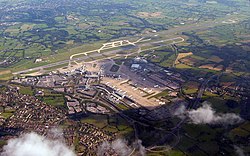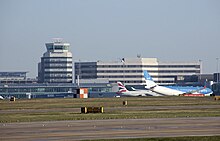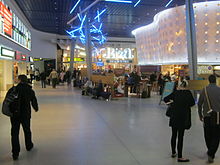Manchester Airport
| Manchester Airport |
|
|---|---|

|
|
| Characteristics | |
| ICAO code | EGCC |
| IATA code | MAN |
| Coordinates | |
| Height above MSL | 78 m (256 ft ) |
| Transport links | |
| Distance from the city center | 18 km south of Manchester, England |
| Street |
|
| train | National Rail |
| Local transport | Bus / Manchester Metrolink |
| Basic data | |
| opening | 1929 |
| operator | Manchester Airports Group, PLC |
| Terminals | 3 |
| Passengers | 27,791,274 (2017) |
| Air freight | 123,576 t (2017) |
| Flight movements |
203,631 (2017) |
| Employees | 19,000 |
| Runways | |
| 05R / 23L | 3047 m × 46 m concrete |
| 05L / 23R | 3048 m × 46 m asphalt |
The Manchester Airport ( IATA : MAN , ICAO : EGCC . Former Ringway Airport ) is an international commercial airport in the northern English metropolitan county of Greater Manchester . It is the UK's largest airport outside of Greater London with over 25 million passengers annually and is operated by Manchester Airports Group Plc. operated.
The airlines Flybe , Ryanair , EasyJet , Thomas Cook , Thomson Airways and Jet2.com have operations bases in Manchester .
history
During the Second World War , the Royal Air Force used the facility under the name RAF Ringway .
Since 2003, a decommissioned is Concorde of British Airways issued on the premises. Due to a change in the orientation of the earth's magnetic field, the runway identifier had to be renamed in 2007 . After 66 years of operation as 06/24 , it has since started and ended up on 05/23 . On September 1, 2010, an Airbus A380 from Emirates landed in Manchester for the first time , and since then it has been regularly serving the airport with it.
Location and transport links
The airport is about 18 km south of downtown Manchester and is connected to the M56 Motorway . There are also several bus connections in the region, and there is also a heavily frequented airport train station , from which various railway companies offer connections to the city center and to other travel destinations inside and outside Greater Manchester . The Manchester Metrolink light rail system has been connecting the airport to local transport since November 2014.
Furnishing
The airport has two runways and three terminals (1, 2 and 3) for passenger handling. Large aircraft such as the Airbus A380 and Boeing 747 can also be handled in regular operations in Manchester .
Terminal 1
Terminal 1 was opened in 1962 and is currently the largest of the three terminal buildings after several extensions, most recently in 2009, with a capacity of around 11 million passengers per year. It has 29 handling positions, one for the Airbus A380 of Emirates is suitable. Around 30 airlines use Terminal 1, with easyJet, Jet2.com and Thomas Cook serving the most destinations.
Terminal 2
Terminal 2, which is about 10 minutes' walk from Terminals 1 and 3, was opened in 1993, has 20 handling positions and is used by around 15 airlines. The terminal was extensively modernized from 2007 to 2009.
Terminal 3
Terminal 3 (previously Terminal 1A and Terminal 1 - British Airways ) was opened in 1989 and is located directly to the east of Terminal 1, but now has no internal connection to Terminal 1. Ryanair and Flybe are the main users of the approximately 13 airlines that use this terminal.
Airlines and Destinations
From Manchester around 180 destinations are served by over 95 airlines worldwide . In addition to numerous domestic connections and European destinations, several long-haul routes with a focus on North America are also offered. Several airlines connect Manchester with airports in German-speaking countries, sometimes seasonally.
Incidents
- On August 19, 1949 was Douglas DC-3 / C-47A of the British European Airways (BEA) ( air vehicle registration G-AHCY ) during the approach to the Manchester Airport flew the airport km north-east into the hills 24th In this CFIT, Controlled flight into terrain , 24 of the 32 occupants were killed (all 3 crew members and 21 passengers).
- On March 27, 1951, crashed Douglas DC-3 / C-47A-75-DL of the Air Transport Charter (G-AJVZ) during takeoff from Manchester Airport shortly after taking off from. The cause was the failure to activate the carburetor preheating , so that one engine failed due to the formation of ice. Two of the three crew members on the cargo flight died.
- On March 14, 1957, a Vickers Viscount 701 of British European Airways (BEA) (G-ALWE) coming from Amsterdam crashed into a residential area in Wythenshawe while approaching Manchester Airport . The cause was the fatigue failure of a landing flap suspension . All 20 occupants of the machine and two people on the ground were killed.
- On February 27, 1958, a Bristol 170 Mk.21E of Manx Airlines (G-AICS) was on a charter flight from Ronaldsway Airport to Manchester when it came to a controlled flight into terrain (CFIT). The plane was leased from parent company Silver City Airways . Since the wrong NDB radio beacon had been selected on the radio compass , a navigation error occurred which resulted in the aircraft being flown 35 kilometers north-northwest of the destination airport in Manchester into the 450-meter-high Winter Hill . Of the 42 occupants, 35 passengers were killed; 4 passengers and the 3 crew members survived. This was the second worst accident involving a Bristol 170 based on the number of fatalities.
- On August 22, 1985 the take-off of a Boeing 737-236 of British Airtours (G-BGJL) , a subsidiary of British Airways, had to be canceled due to an engine fire at Manchester Airport. The pilots brought the aircraft to a halt, but the fire, fanned by the prevailing winds, spread to the cabin after just under a minute. Of the 137 people on board, 55 died, most of them from smoke inhalation (see also British Airtours flight 28M ) .
Basic data
| year | Checked in passengers | Flight movements |
|---|---|---|
| 1997 | 15,948,454 | 94,318 |
| 1998 | 17,351,162 | 100,099 |
| 1999 | 17,577,765 | 107,803 |
| 2000 | 18,568,709 | 116.602 |
| 2001 | 19,307,011 | 106.406 |
| 2002 | 18,809,185 | 113.279 |
| 2003 | 19,699,256 | 122,639 |
| 2004 | 21,249,841 | 149.181 |
| 2005 | 22,402,856 | 147.484 |
| 2006 | 22,422,855 | 148,957 |
| 2007 | 22.112.625 | 165.366 |
| 2008 | 21,219,195 | 141,781 |
| 2009 | 18,724,889 | 102,543 |
| 2010 | 17,759,015 | 115,922 |
| 2011 | 18,892,756 | 158.025 |
| 2012 | 19,736,502 | 168,883 |
| 2013 | 20,751,581 | 169.497 |
| 2014 | 21,989,682 | 170,639 |
| 2015 | 23.136.047 | 164.710 |
| 2016 | 25,637,054 | 183.731 |
| 2017 | 27,791,274 | 203,631 |
| 2018 | 28.275.972 | 201.239 |
Individual evidence
- ↑ a b c Manchester Airport celebrates a bumper year. ManchesterAirport.co.uk, January 11, 2018, accessed January 14, 2018 .
- ↑ Manchester Airport & MAG. ManchesterAirport.co.uk, accessed January 14, 2018 .
- ↑ Airport data on World Aero Data ( English, as of 2006 )
- ↑ Allocation of airlines to terminals on manchesterairport.co.uk
- ^ Accident report DC-3 G-AHCY , Aviation Safety Network (English), accessed on August 10, 2019.
- ^ Accident report DC-3 G-AJVZ , Aviation Safety Network (English), accessed on August 10, 2019.
- ↑ Accident report Viscount 700 G-ALWE , Aviation Safety Network (English), accessed on August 19, 2017.
- ↑ Maurice J. Wickstead: Airlines of the British Isles since 1919 . Air-Britain (Historians) Ltd., Staplefield, W Sussex 2014, ISBN 978-0-85130-456-4 , p. 318.
- ↑ ICAO Aircraft Accident Digest No. 10, Circular 59-AN / 54 (English), pp. 83-92.
- ↑ Air-Britain Archive: Casualty compendium part 72 (English), March 1999, pp. 99/28.
- ^ Accident report Bristol 170 G-AICS , Aviation Safety Network (English), accessed on August 4, 2019.
- ↑ Datasets | UK Civil Aviation Authority. Retrieved June 26, 2020 .
Web links
- Website of Manchester Airport (english)


